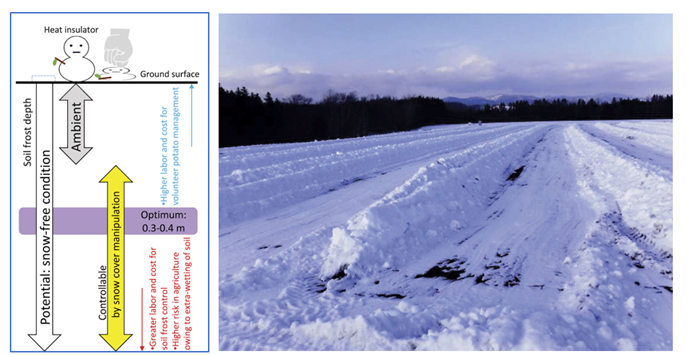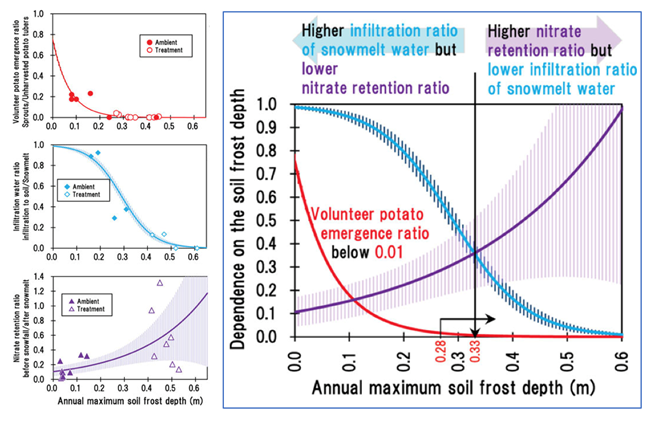Towards harmonization of improving productivity while reducing environmental load in cold region agriculture
The Hokkaido Agricultural Research Center (HARC/NARO) identified the optimum soil frost depth in on-farm soil frost control method "yukiwari" for efficient management of volunteer potatoes. Controlling the soil frost depth to approximately 30 cm facilitates reduced emissions of greenhouse gases from soil and the reaching of nitrate, while preventing the overwintering of potatoes. This result is useful for improving agricultural productivity in cold regions with reducing environmental load.
Overview
- In Tokachi region of eastern Hokkaido, soil freezes in winter because of severe cold. However, in recent years, snow accumulation in the early winter has increased and soil frost depth has become shallow due to the insulation effect of snow. As a result, weeding problem by overwintering unharvested potatoes becomes serious problem.
- HARC/NARO has established mathematical model for soil frost control based on snow plowing (termed "yukiwari" in Japanese), which can be an effective countermeasure to prevent volunteer potatoes. Originally, snow plowing had developed by the local farmers with trial-and-error approach to eliminate volunteer potatoes.
- In general, excessive development of soil frost depth has adverse effects on agriculture, such as soil erosion during the snow-melting period and delays in the initiation of agricultural activity because of the excessive wetting of soil in the early spring. Furthermore, there are also concerns of temporarily large emissions of greenhouse gas (nitrous oxide, N2O) after snowmelt and an increased risk of water pollution by the leaching of residual nitrate in the surface soil.
- In the present study, on-farm snow cover manipulation experiments have been conducted to determine the optimum soil frost depth that can eradicate unharvested potato tubers without affecting agricultural activity initiation while minimizing nitrate pollution from agricultural field. By controlling the depth at which the soil freezes to about 30 cm (at least 28 cm, at most 33 cm), water pollution caused by the reaching of nitrate derived from fertilizer remaining in the field is also suppressed.
- Soil frost control is a promising practice to alleviate climate change effects on agriculture in cold regions. In addition to avoiding the emission of greenhouse gases, it also helps improve productivity.
For Inquiries
Contact: http://www.naro.affrc.go.jp/english/inquiry/index.html
Publication
Yosuke Yanai, Yukiyoshi Iwata, Tomoyoshi Hirota (2017) Optimum soil frost depth to alleviate climate change effects in cold region agriculture. Scientific Reports 7: 44860 DOI: 10.1038/srep44860
Reference Information






